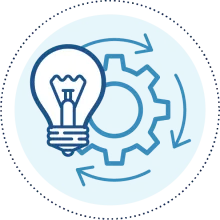Quick Downloads: Career Conversations Form | Employee UAccess Upload Guide (PDF)
How Career Conversations Benefit You
Career Conversations are an important tool to help you take control of your professional development and career growth. Use them to explore career goals, receive ongoing feedback, and discover what learning opportunities can support your professional development.
Career Conversations Guidance: Changes in Reporting Structures
This year, some reporting structures have undergone changes as part of the centralization efforts. This may affect the way you approach Career Conversations this year.
Planning for the upcoming year can be challenging if your role is shifting or you do not have an existing relationship with your supervisor. Consider the following adjustments as you engage in the Career Conversation process.
If you are an existing University employee reporting to a new supervisor
Your new supervisor is responsible for signing off on your Career Conversation in UAccess. Consider these two options.
- Hold a joint Career Conversation with your new and former supervisor. This will ensure that your conversation reflects your accomplishments and ongoing development plans.
- Hold a Career Conversation just with your new supervisor. In the conversation, focus on showcasing your previous skills and strengths. Sharing last year's conversation with your new supervisor can help them prepare.
If your job scope is changing or if you are a new hire
In a new or shifting role, it may be challenging to map out SMART goals and learning opportunities for the upcoming year. Suggestions to approach Career Conversations:
- Instead of filling out the Career Conversation form, use it as a guide to have open conversations with your new supervisor to reflect on your career objectives, experiences, needs, and growth goals. Summarize your conversation in a Word document and upload it to UAccess.
- Wait 4-6 months before having your Career Conversation with your supervisor. At that point, you'll better understand your role and make more informed decisions about your career goals.
Keys to Success
- Take time for you and your supervisor to get to know one another and outline ways you would like to work together for the upcoming year. How can you remain curious, open, and adaptable as you realign your work?
- Remain flexible. You may need to adapt to the process this year. Do what works best for you and your supervisor.
Resources & How-Tos
The Career Conversations Process
The Career Conversations process model consists of five steps. Read through each step or watch a short video at the link below.
Deconstructed Career Conversations Form
Filling out the Career Conversations form can be intimidating. This page is designed to help you feel confident in the process, better understand its components, and feel comfortable providing impactful answers.
Career Growth Resources from LinkedIn Learning
LinkedIn Learning has created a resource collection to help you create professional goals and career development strategies. These videos can help you articulate your accomplishments, strengths, and goals.
Frequently Asked Questions
All benefits-eligible staff should engage in the Career Conversations process. However, we encourage all University staff to engage in a form of career planning with their supervisors.
The formal Career Conversations process should be completed with staff who have been in their role for at least six months. That provides enough time for the staff member to understand their position well enough to strategically plan for the future.
Prior to six months, supervisors and their staff should engage in regular feedback about job expectations and success as part of the onboarding process.
- Before the University had a common date for completing Career Conversations, staff feedback shows that the process felt unclear and that Career Conversations didn't always happen. The April - June window:
- Accommodates both academic and fiscal timelines
- Establishes the expectation for staff members and supervisors for an annual process
- Allows for tools and resources to be developed and shared with you
- Streamlines communications sent to your inbox
- Will enable easier tracking of completion rates
It can be difficult to express disagreement with a supervisor, but honest conversations make for better working relationships. If the supervisor chooses not to change the comments following a conversation, the staff member may document the disagreement on the Career Conversations form.
Career Conversations are not intended to compare staff members to one another, but rather to develop individualized development plans for each person.
Completion of Career Conversations is separate from pay decisions; however, performance issues discussed in the Career Conversations process, such as not meeting goals or addressing areas of needed and expected improvement, are part of the staff member's record. Career Conversations records would be evaluated to determine merit pay or potential disciplinary action.
There are three easy ways to sign the Career Conversations form (DOCX).
- Sign the form physically and scan it. Upload the scanned document to the UAccess Career Conversation module.
- Type names directly into the form in Steps 2 and 3. The employee uploading this document to UAccess and the supervisor approving it will act as signature verification.
- Use Adobe Sign. Review the Completing Career Conversations in Adobe Sign (PDF) for instructions.



